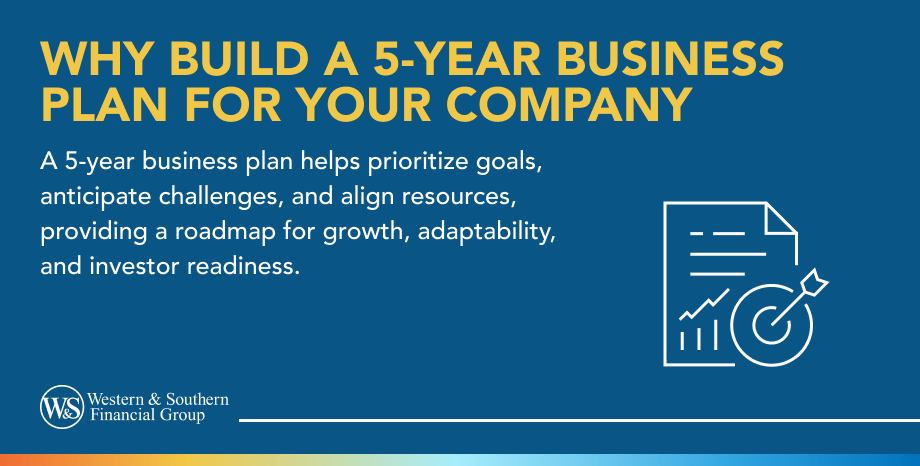

Table of Contents
Key Takeaways
- A 5-year business plan identifies company goals and strategies to achieve them.
- A long-term plan anticipates potential obstacles and strengths to be proactive.
- A 5-year plan demonstrates a growth vision to potential investors and expansion strategies.
- Review past financial data and sales numbers to create realistic growth projections.
- Include solutions like employee benefits and buy-sell agreements to support your plan's goals.
When you're running a small business, every day is so busy that it can be hard to find time for long-term planning. Who can think years ahead while trying to make payroll in a week?
But creating a long-term business strategy has several advantages, for both your business and your personal finances. Let's take a closer look at why a five-year business plan is a good idea and how you can develop one.
Why Make a Five-Year Business Plan?
Establishing a long-term plan can help you determine your priorities and goals for your business. Do you want to expand to new locations? Maximize sales? Transfer the business to a family member? Each goal will involve different priorities for your time and resources. By mapping out a plan, you can make sure that you and your staff are pursuing these goals and not wasting resources.
A five-year plan can help you identify any potential obstacles, as well as the possible strengths that could help propel you toward your goals. This kind of strategic thinking can help prepare you for the unexpected, so that you aren't caught off guard.
Finally, if you ever plan to raise money from investors, they will want to see your business plan. Having a five-year plan can help prepare you for these meetings.
How to Develop a Five-Year Plan
A five-year plan should cover your business's current functions and practices, as well as its goals. This includes your goals for marketing, operations and finances. Review your past financial results and sales data, and use that help to predict future growth. If you think previous trends will change because of certain interventions, explain that in your projections. For instance, perhaps you expect a growth in sales because of a new product launch.
Ask yourself specific questions about your business: With your current practices, how many clients can you gain in the next five years? How much could your revenue realistically grow? Do you need to hire new staff members, and how many do you plan on hiring?
By pinpointing where you'd like to be in five years, you can start setting milestones. If you'd like to earn a certain amount of revenue in year five, how much do you need to earn in year three to be on track? In year one? In six months? These considerations can help you develop action items. For instance, if your priority is to grow sales, then you can set action items like increasing the number of sales calls you make and growing your marketing budget.
Identifying Your Business's Strengths & Weaknesses
As you brainstorm, you may want to run a SWOT analysis on your plan.1 A SWOT analysis lists a company's strengths, weaknesses, opportunities and threats. For example, a strength could be your dedicated and talented sales team that can help grow your revenue.
A weakness could be overreliance on a single person for product development. With that information, you can start imagining how your business would handle different challenges. For example, how much could an economic recession lower your sales? What can you do now to make sure you'd have enough cash to manage?
Consider how you can capitalize on your strengths and opportunities while minimizing the potential damage from your weaknesses and threats. For example, you could hire a backup employee for product development and motivate your sales team with attractive bonuses.
Finding Solutions to Reach Your Business Goals
You should also consider some small business financial solutions to help bolster your strengths and offset potential weaknesses to help reach the goals you set in your five-year business plan. If one of your strengths is your talented employees, your goal could be to reduce turnover. One way to achieve this goal could be improving your employee benefits. Consider providing your employees with life insurance or a workplace retirement plan.
Likewise, you and your partners could establish a buy-sell agreement detailing a course of action to take if one of you passed away, including a plan for the deceased partner's shares. By preparing for these potential events, you can keep your business on track with your projections even when something negative happens.
Life is unpredictable, and your business outcomes will likely differ from your current forecast. But by putting together a five-year plan now, you'll be more likely to stay on track and be successful.
Sources
- What is a SWOT Analysis? (And When To Use It). https://www.businessnewsdaily.com/4245-swot-analysis.html.











